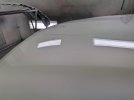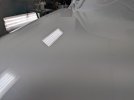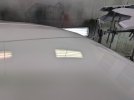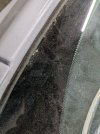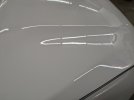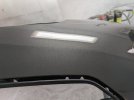serjik911
Promoted Users
Hello everyone.
car #1.
sealed, and put base coat, white color. Temp 70, side draft spray booth. let it sit overnight. Came back in a morning, everything look great. Sprayed 2 coats of spi universal medium, 30 mins between coats. looks great. after 15 mins turned off fan, everything looks good. In few hours started to see some contamination or solvent pop. And after a day drying took a picture. Contamination/pop is on each panel, horizontal or vertical. and on right side of the hood its a lil bit more, than everywhere else. Checked the thickness and in average have 2 mils of clear everywhere.
car #2.
sealed, base coat, let it sit overnight. everything looks great. in a morning cleared with different faster clear, by tds has 3 mins flash between coats, which i did. 2 full wet coats. after 15 mins turned fan off. in 2 hours the clear was good to touch, and i see less but same pop/contamination as on first car. And this time, if i look very close and straight to it, it even has some grey color in it.
The shop is located next to demolition and construction waste recycle, and when plant works, everything around 3 miles is in dust, like on photo. Its like nuclear winter, honestly.
when i turn on the booth, i dont see noticeable dust, but yesterday i turned off booth lights and and turned on just a flashlight, and saw a lot of micro dust coming thru filters.
So, I am pretty sure that it is contamination, but, the only thing i dont get is why dont i see it right away as i spray clear coat, and only after it starts drying up to the next day?Why it looks worse on a good slow clear coats and better on cheap fast clears? It also affects clear coat depth. Is it contamination or its a solvent pop?
Thank you
car #1.
sealed, and put base coat, white color. Temp 70, side draft spray booth. let it sit overnight. Came back in a morning, everything look great. Sprayed 2 coats of spi universal medium, 30 mins between coats. looks great. after 15 mins turned off fan, everything looks good. In few hours started to see some contamination or solvent pop. And after a day drying took a picture. Contamination/pop is on each panel, horizontal or vertical. and on right side of the hood its a lil bit more, than everywhere else. Checked the thickness and in average have 2 mils of clear everywhere.
car #2.
sealed, base coat, let it sit overnight. everything looks great. in a morning cleared with different faster clear, by tds has 3 mins flash between coats, which i did. 2 full wet coats. after 15 mins turned fan off. in 2 hours the clear was good to touch, and i see less but same pop/contamination as on first car. And this time, if i look very close and straight to it, it even has some grey color in it.
The shop is located next to demolition and construction waste recycle, and when plant works, everything around 3 miles is in dust, like on photo. Its like nuclear winter, honestly.
when i turn on the booth, i dont see noticeable dust, but yesterday i turned off booth lights and and turned on just a flashlight, and saw a lot of micro dust coming thru filters.
So, I am pretty sure that it is contamination, but, the only thing i dont get is why dont i see it right away as i spray clear coat, and only after it starts drying up to the next day?Why it looks worse on a good slow clear coats and better on cheap fast clears? It also affects clear coat depth. Is it contamination or its a solvent pop?
Thank you

